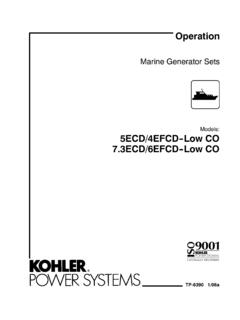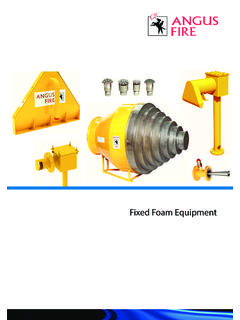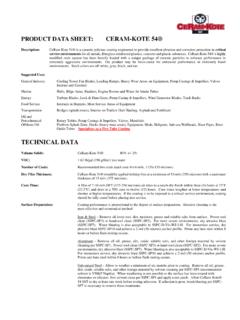Transcription of 07-2007 Marine Wind Generator Test - Naviclub.com
1 Marine wind Generator Test Practical Sailor s search for the best Marine wind Generator for cruising sailors unearthed two new units that will give the old guard a run for their money. The German-made Superwind 350 and a lightweight prototype of the Air Breeze from Southwest Windpower, churned out maximum amps during four days of micro- wind turbine test. The micro- wind turbines assembled for this comparison include the KISS High Output wind Generator , the Rutland 913, the Superwind 350, the Ampair 100, and a prototype of the Air Breeze. The four-day test period brought a good mix of light- and strong- wind days, so testers were able to review wind Generator output in a variety of conditions. wind speeds for the 4-day period averaged knots, with two blustery days, so we re not surprised the high-output, three-bladed wind generators topped the five-bladed ones overall. ** Last month, Part One of Practical Sailor s wind Generator test "Choosing a wind Generator ," examined the various types of Marine wind generators on the market today, and discussed what to consider before buying one.
2 That article also previewed some of the key differences between the five wind generators we tested in March on the shores of Chesapeake Bay. This article examines these generators in more detail and presents the results of our field test, which tracked wind speed and output of the five wind generators over the course of four consecutive 24-hour periods. The turbines assembled for this comparison include the KISS High Output wind Generator , the Rutland 913, the Superwind 350, the Ampair 100, and a prototype of the Air Breeze. (A sixth unit, the three-bladed Ampair 300, looked promising, but failed on the first day of testing. It has been repaired, and PS will be reviewing it in a future issue.) The tested units fall into one of two distinct categories: three-bladed wind generators with large-diameter rotors and high maximum outputs (Superwind, KISS, and Air Breeze) and six-bladed wind generators with small-diameter rotors and lower maximum outputs (Ampair 100 and Rutland).
3 As pointed out in last month s article, there are key differences between these types of turbines. The six-bladed units generally begin generating power in less wind and run quieter. The three-bladed units deliver significantly more amps as wind speed increases. wind Generator makers Hamilton Ferris and Four Winds Enterprises were asked to provide products for the comparison, but neither could meet the deadline for the test. We have looked at units from these manufacturers before. The Hamilton Ferris hybrid water/ wind was reviewed in our Feb. 15, 2003 issue. The earlier version of the Four Winds II was among several units compared during long-term testing in 1994 and 1995. The long-term test (Nov. 15, 1995) evaluated several different wind generators , one at a time, over several weeks and monitored output. Ultimately, Practical Sailor concluded that although wind generators are effective at producing high output in ideal conditions, their output in the winds you can expect in a comfortable harbor is less than stellar when averaged over the long haul.
4 Only one For four days in March, the Norfolk Naval Station MWR Marina in Norfolk, Va., hosted the field-test element of our wind Generator comparison. The weather delivered a good mix of light-and strong- wind days. Generator in that test, the wind Baron Neo Plus (no longer available, as far as we know) delivered more than 100 amp hours over 24 hours, and none had an average daily output greater than 10 amp hours, which is less than can be expected from one 80-watt solar panel on a moderately sunny day. Until this year, one obvious question remained unanswered, however: How would various micro turbines fare if exposed to the same variable winds in the same location for a fixed period of time? Air Breeze (prototype) Southwest Windpower, makers of the popular AirX Marine line of wind generators , supplied us with a prototype of the Air Breeze, which will soon be sold through West Marine . The unit we tested was essentially the new Air Breeze software and blades housed in an AirX body.
5 Note that Practical Sailor is withholding any final judgment on the Air Breeze, until we are able to test the final product. The specs for our tested model were not readily available, but testers were told that they closely mirror that of the production Air Breeze, described here. The Air Breeze will be available in 12-, 24-, or 48-volt DC models and has a rated power of 200 watts at 19 knots. It uses a three-phase, brushless permanent magnet alternator, which produces AC power that is internally rectified to DC. Turbine control is via a microprocessor-based smart internal regulator utilizing peak power tracking. However, the Air Breeze also has an internal voltage regulator with a factory set point of volts (12-volt turbine) or volts (24-volt system). The set point is also field adjustable to suit different charging regimes (an AGM battery, for example). This setup allows the unit to self-regulate in high winds and to automatically stop when the batteries are charged.
6 Normal charging resumes when the battery voltage drops slightly below the fully charged level. The body of the prototype unit (as well as the Air Breeze) was powder-coated cast aluminum. Construction of the prototype unit was excellent. Like the AirX before it, the Air Breeze has a distinct, downward pointing tail fin with a small cutout. The manufacturer says this allows for better tracking of the wind and better stability in rough seas. Oddly, testers noted this unit had more of a tendency to rotate briefly away from the wind , even in a steady breeze, but this seeking didn t keep it from producing the second highest total output in our test. The Air Breeze was by far the easiest unit to mount in our test. The base simply slides on and clamps to a 1 -inch diameter schedule 40 pipe, providing 360 degrees of continuous operation. The blades were constructed of glass-filled polypropylene. The maker says an improved rotor and blades will be on the production model.
7 Start-up speed is reported as 6 knots, while maximum or "survival speed" is listed as 96 knots, with over-speed protection provided automatically by electronic torque control, and manually by an optional stop switch. The Air Breeze also uses stall control of the blades. According to the makers, this function is much quieter than it was in previous models (such as the AirX and 403), since the stall mode is activated by the controller before the flutter RPM is reached. The result is a dramatic reduction in RPM in wind speeds above 30 knots, reduced wear on blades and bearings in high winds, and most importantly protection of the turbine from damage due to high winds. Stall mode is activated at about 19 knots, and will stay in effect until wind speed drops below 19 knots. If the Air Breeze senses wind speeds above 43 knots, it will shut down completely for five minutes. The Air Breeze finished less than 6 amp hours behind the best recorded output for each 24-hour period.
8 Bottom Line: Pluses for the Air Breeze prototype include high output (second overall), light weight (lightest overall), quiet operation, easy installation, excellent construction, and a low price. The unit will soon be available at West Marine for $915, according to the manufacturer. Testers also liked the charge LED display on the bottom of the unit, which gives a visual indication of unit output and can be used as a troubleshooting aid. The Air Breeze s downside is its limited field repair options, unless there have been significant changes from the AirX unit it replaces. AMPAIR 100 One of two small-rotor units tested was the Ampair 100 manufactured by Boost Energy Systems of Berkshire, A six-bladed unit, the Ampair 100 has a maximum output of 100 watts and produces AC, which is then converted to 12- or 24-volt DC (selected at time of order) by two bridge rectifiers located in the unit s lower body.
9 The DC output of the regulators is paralleled and passed to two carbon brushes (also mounted in the lower body) and then to two phosphor-bronze slip rings (mounted on the stationary pivot shaft) allowing the unit to follow the wind 360 degrees without the use of commutator brushes. According to the manual, maximum output current automatically remains at a safe level due to self-inductance of the heavy-duty windings it goes on to say that similar sized machines (with low inductance and light-duty windings) have to be protected against burnout by the use of temperature-activated cut-out switches. The Ampair 100 is built like a tank. The unit consists of a painted, two-part cast aluminum body with attached aluminum tail vane. Fit and finish were excellent, and all other inspected external components were either stainless steel or of composite construction. Internally, there are two six-pole permanent magnet rotors (with poles in line) mounted on a stainless-steel shaft, which runs in two sealed, grease-packed ball bearings.
10 Two six-pole stators (one located in the main body casting, the other in the nose cone) are arranged with their poles staggered at 30 degrees to minimize "cogging," which can prevent a rotor from starting in light winds. Although the Ampair 100 produces AC, its bridge rectifiers are located within the unit base (eliminating the need for a separate box), so installation is essentially the same as a unit that produces direct DC. If a blade is damaged, it and its opposing mate will have to be replaced together. However, you can run the unit (at reduced performance) with two blades removed until you get your replacements. Start-up speed for the Ampair 100 is approximately 7 knots, and while the maker designates no maximum wind speed (only that it s designed to survive storms), its manual does state that it s a good plan to secure the unit if a severe storm is expected. There is a stop switch option.








